Midsummer garden walkabout
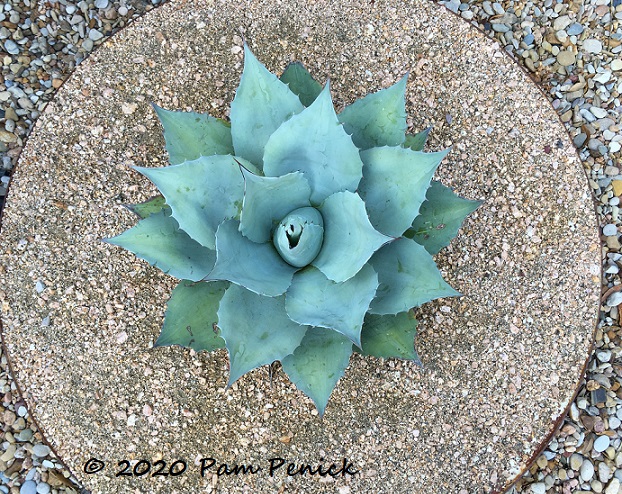
Midsummer has never been my favorite season in the garden. It’s hot and humid. Mosquitoes are fierce. And yet this summer, perhaps because I’m spending more time at home and in my own garden than usual, I’m also appreciating it more. Here’s what’s caught my eye lately on strolls around the garden.
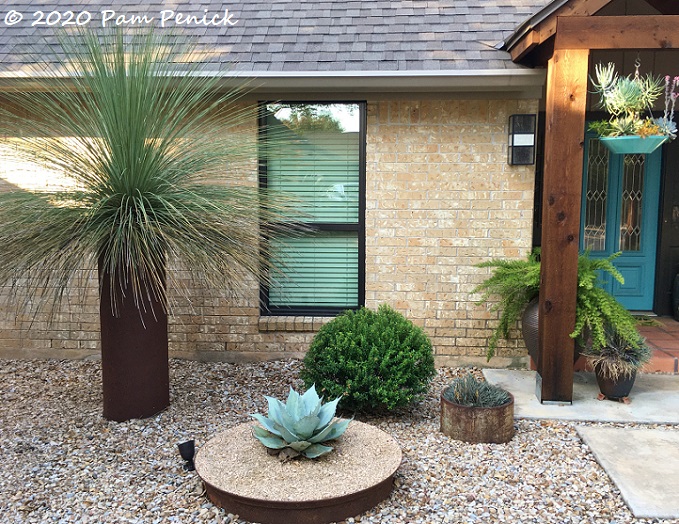
The gravel garden by the front door is looking pretty bouncy with lots of circular planters and spherical plants, like the clipped dwarf myrtle (Myrtus communis ‘Nana’) and toothless sotol (Dasylirion longissimum) in the steel pipe. Whale’s tongue agave (Agave ovatifolia) and ‘Frazzle Dazzle’ dyckia grow in the shorter steel containers. These are all super-tough plants for a hot, dry location.
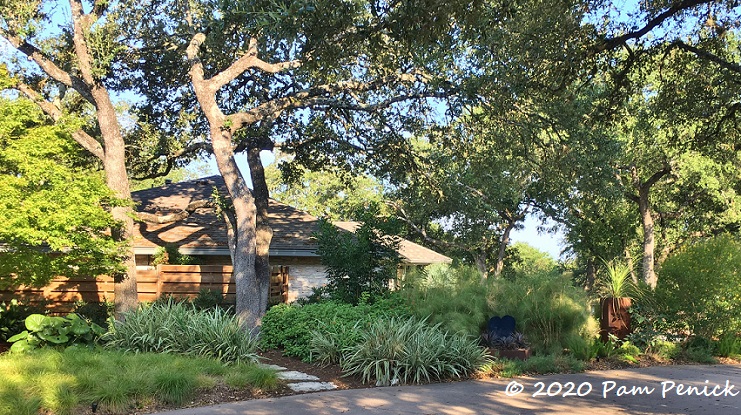
I really love how the driveway bed has filled in over the past several years. I now enjoy complete screening of the neighbors’ driveway. With heavy deer pressure in my front garden, these are all very deer-resistant, plus shade-tolerant, plants.
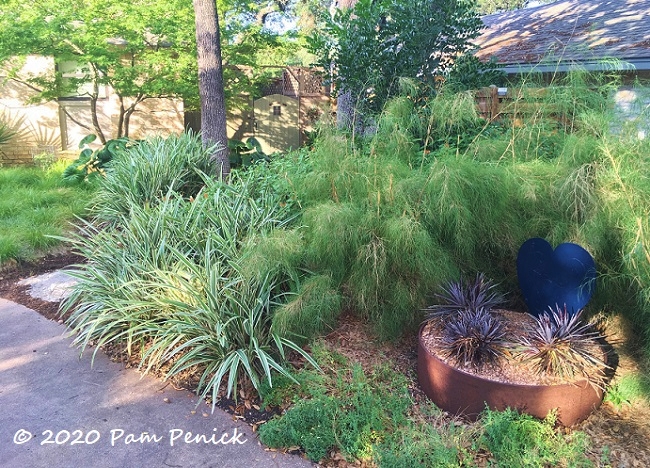
A trio of shiv-leaved ‘Burgundy Ice’ dyckias pair with a blue steel heart in another pipe planter, embraced by a cloud of bamboo muhly (Muhlenbergia dumosa). White skullcap (Scutellaria suffrutescens ‘White’) makes a foamy groundcover in front, its tiny white flowers echoing the stripes of variegated flax lily (Dianella tasmanica ‘Variegata’) at left.
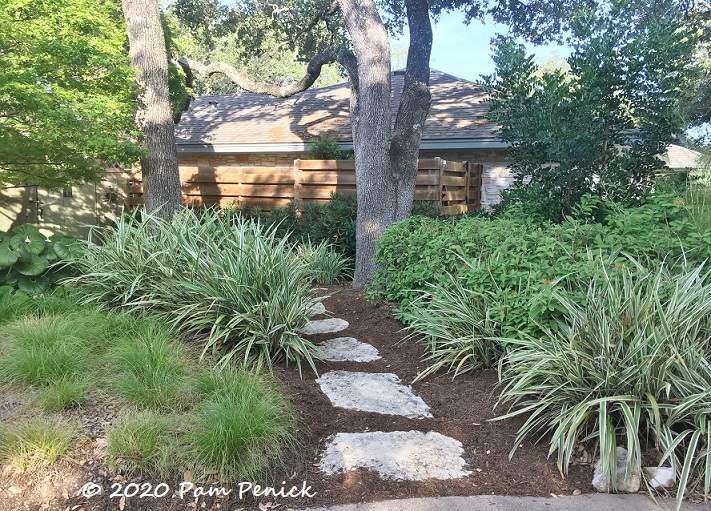
The flax lily “jumps” (I planted it this way) across a flagstone path that leads to the side gate. It’s grown so big, after a couple of mild winters, that I’ve had to start whacking it back from the path. I have a sneaking suspicion that the deer brought chiggers into my garden because I was getting itchy bites behind my knees after walking through this area, when the dianella leaned over the path. No bites since cutting it back — yay!
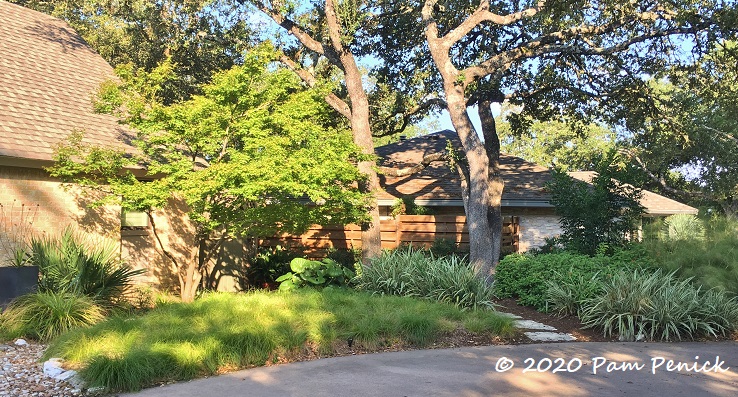
A wider view shows the sedge lawn (Carex leavenworthii) and Japanese maple in front of the house.
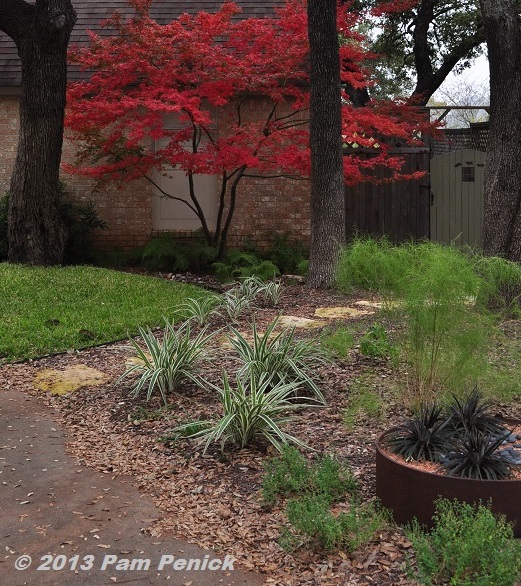
For a fun comparison, here’s how this area looked in December 2013, with young dianella and bamboo muhly, and the sedge lawn had not yet replaced the St. Augustine. I like looking at old blog posts to see how much the garden has grown or changed.
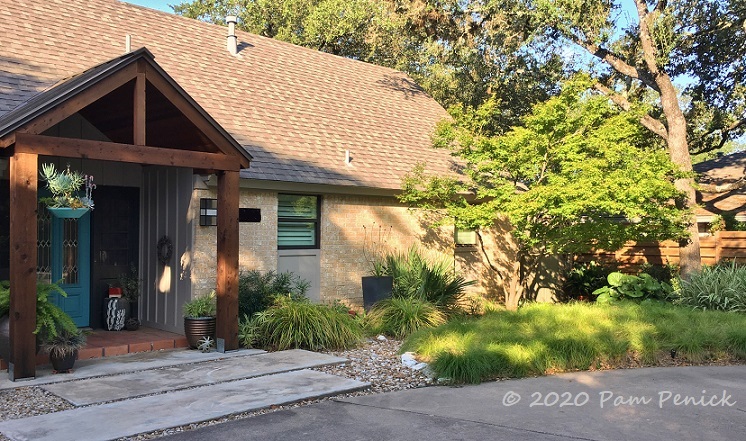
Panning left toward the front porch, sharp-eyed readers may notice something missing in the foundation bed…
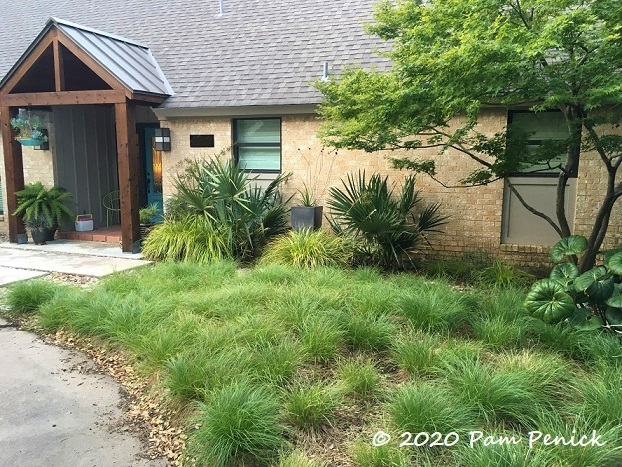
…a Texas dwarf palmetto (Sabal minor) next to the porch column. This is the before picture. A pair of palmettos grew here for a couple of years, until I realized the extra water from being under the eave was causing them to grow much faster than expected.
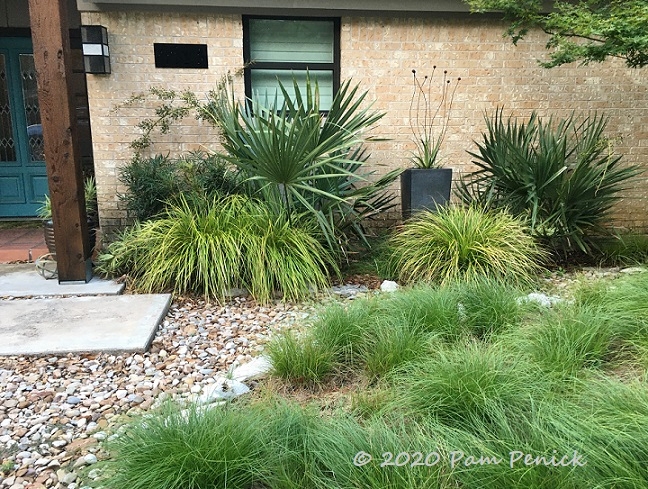
While I enjoyed seeing fronds out the window, it required regular pruning. And it was only going to get bigger. So I moved it to the back garden, where I’m trying to keep it well watered and alive until it recovers from transplant shock. In my experience, Sabal minor doesn’t like being transplanted, but hopefully it’ll take hold in its new spot. I’ve planted ‘Amistad’ salvia and ‘Sparkler’ sedge in its place. The yellow-green, grassy plants along the foundation are ‘Everillo’ sedge, a favorite of mine for shade or morning sun.
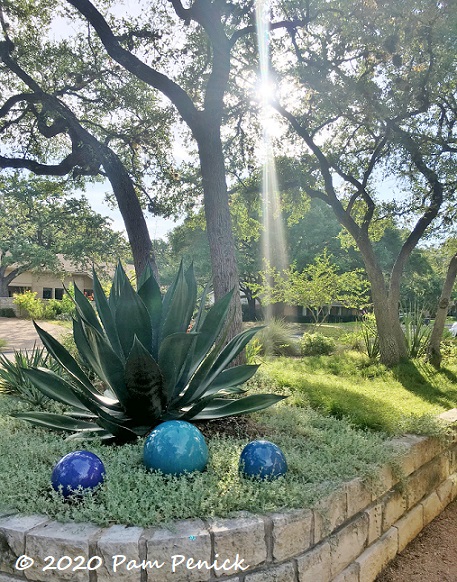
On the east side of the circular driveway, the dusty-green leaves of ‘Green Goblet’ agave reign over woolly stemodia (Stemodia lanata), a silvery native groundcover. That’s Berkeley sedge (Carex divulsa) in the background, with ever-present live oaks filtering the morning sun.
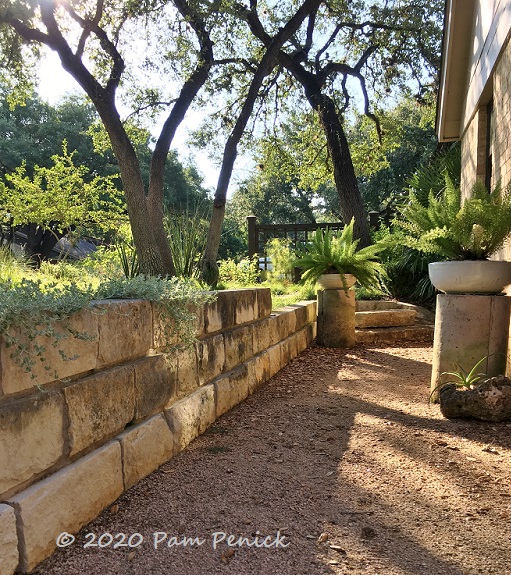
Potted and elevated foxtail ferns (Asparagus densiflorus ‘Myersii’) draw you along the gravel path that cuts in front of the garage.
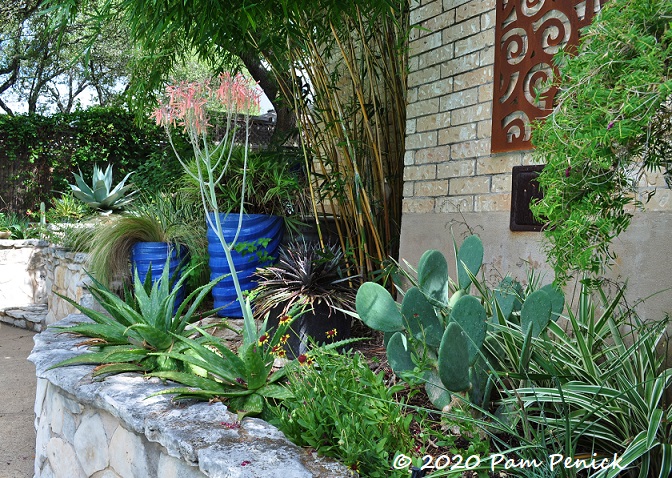
Meanwhile, in the back garden, soap aloes (Aloe maculata) have been blooming regularly all summer. I’ve struggled with the blazingly hot and dry space in front of the south-facing chimney wall, and last fall I added a spineless prickly pear, which I’ll carefully prune to give it a good shape as it grows. An uplight is trained on it, and I anticipate good shadows when it gets a little bigger.
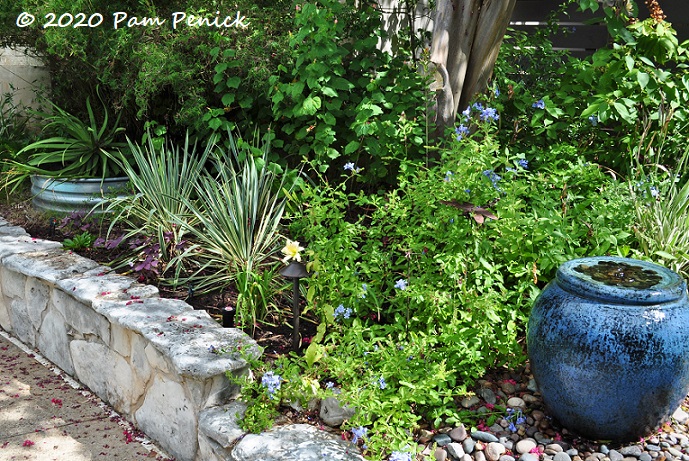
A trio of ‘Bright Edge’ yuccas have finally brought definition to another troublesome spot near the fountain. A number of plants have failed here over the years, but maybe I’ve finally found the right one. Plumbago’s blue flowers echo the blue of the pot fountain.
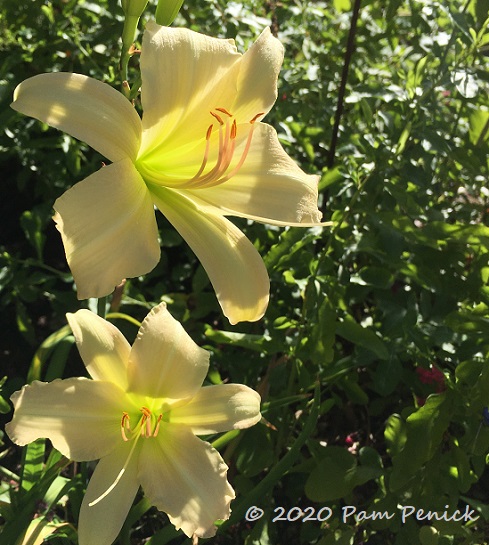
Weirdly, my daylilies started blooming in late July and early August. They normally bloom in May, but nothing this spring. And now look. ‘Best of Friends’, normally a peachy-pink, looks washed out in the blistering heat, but I’ll take it. Hey, it’s August.
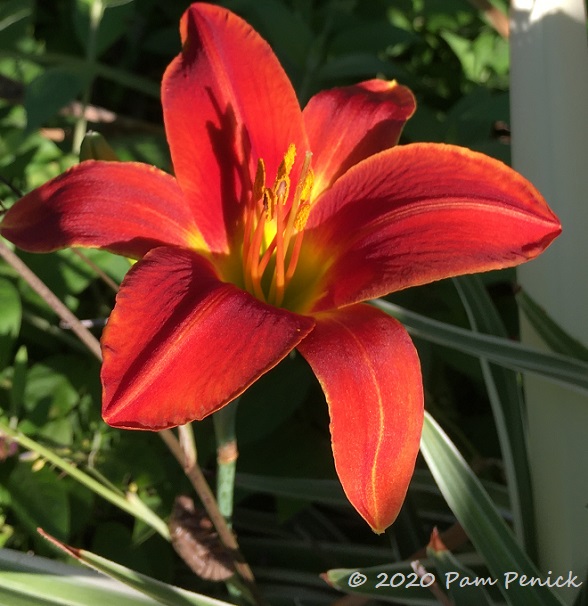
‘Apple Tart’ daylily’s rich red coloring is holding up much better.
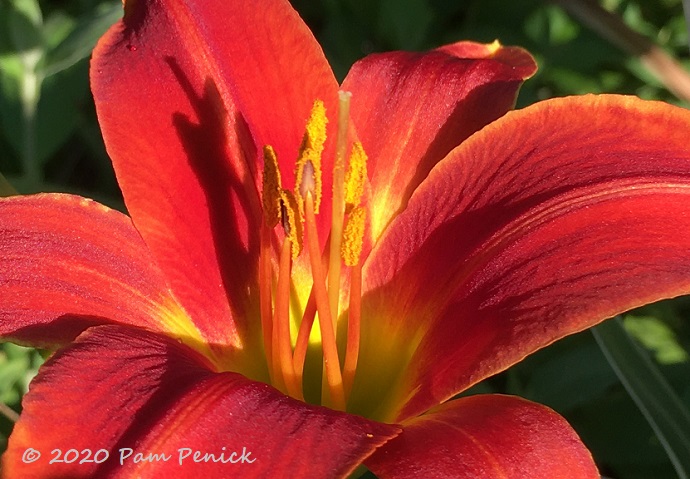
I love that hit of chartreuse in the center.
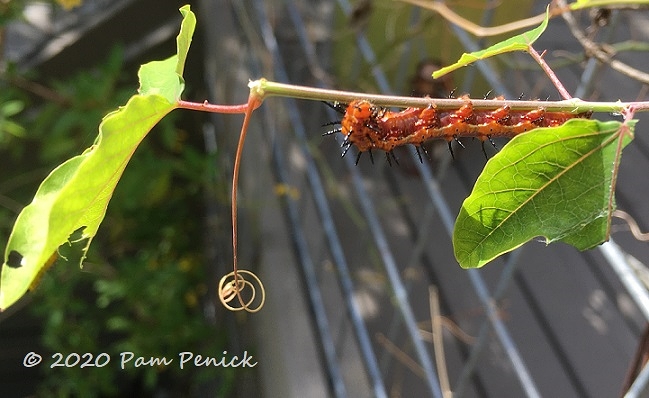
The ‘Lavender Lady’ passionflower on the deck rail has been denuded by caterpillars since the spring, but I do have lots of pretty Gulf fritillary butterflies to enjoy.
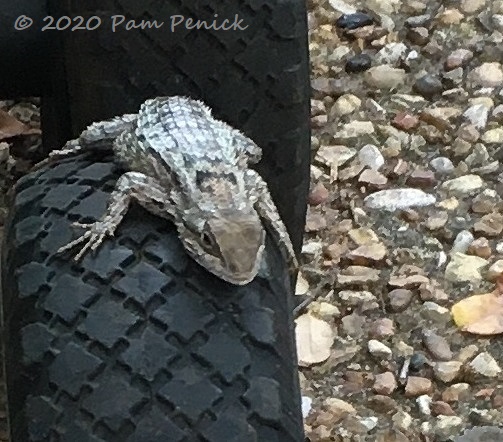
During the dog days of summer, one can feel pretty tired — but a hose-cart tire makes a good resting place for this Texas spiny lizard!
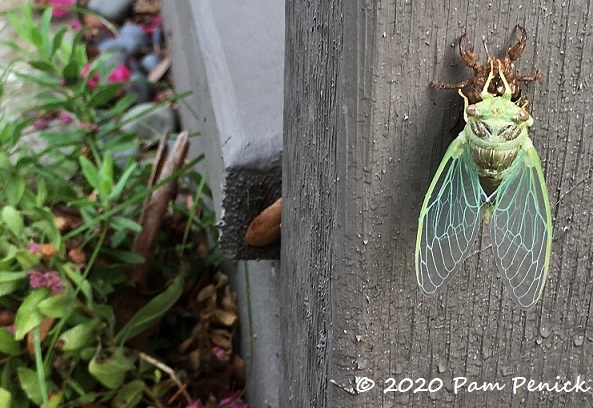
Cicadas buzz all day long, and I’m constantly finding their “shells” clinging to fence posts, trees, and deck rails. Recently I spotted this newly emerged cicada resting atop its old exoskeleton, drying out its seafoam-green wings.
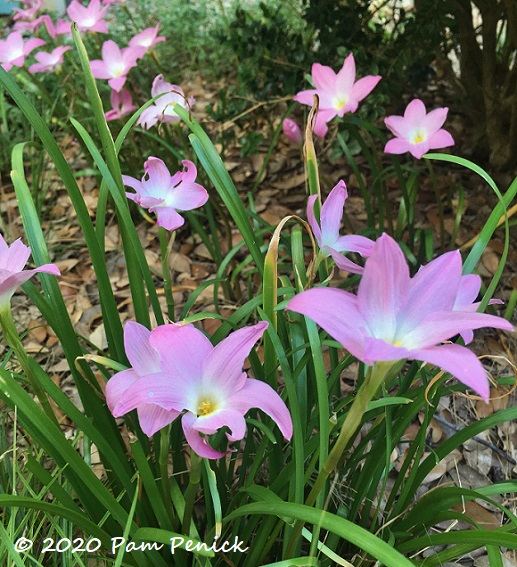
And a rain shower brought up the pink rain lilies (Zephryanthes ‘Labuffarosea’), always a welcome sight — the flowers and the rain too.
__________________________
Digging Deeper
Come learn about gardening and design at Garden Spark! I organize in-person talks by inspiring designers, landscape architects, authors, and gardeners a few times a year in Austin. These are limited-attendance events that sell out quickly, so join the Garden Spark email list to be notified in advance; simply click this link and ask to be added. Season 8 kicks off in fall 2024. Stay tuned for more info!
All material © 2025 by Pam Penick for Digging. Unauthorized reproduction prohibited.


It is obvious that your garden is enjoying your extra attention. It looks great. I love seeing the wildlife in and around your garden. That is a good picture of the spiny lizard. I have tried getting pictures of them and I never see the spines. They always run away before I can even focus. ha… Seeing your Whale’s Tongue Agave reminds me to tell you that the Moby pup is growing quite well here. I had to pot up the bruiser this year. I don’t know what I will do with it when it continues to grow larger. It doesn’t look as beautiful as the one in your garden. I imagine it’s less than ideal winter quarters is the reason. I still enjoy it though. I always think of you when it pokes me. 😉
Hah, Lisa, your comment made me laugh out loud! Moby Jr. sounds a lot like its parent. It’ll nip if you’re not careful. 🙂
Your garden is looking gorgeous, Pam! After years of reading your blog, I still get lots of inspiration from seeing your photos. The driveway bed is a work of art. And the toothless sotol in the pipe planter has filled out so nicely. It’s sort of like having a yucca rostrata, but the height is fixed, which I love. I’m eyeing a place to put a yucca rostrata in my front bed, but I know that one day – maybe many years from now – it will get too big. Hmmm…wheels turning on the pipe idea.
Thanks, Maggie. My Yucca rostratas have grown pretty fast given plenty of sun. I hope you find a spot to squeeze one in though. It’s such a gorgeous plant! The toothless sotol may actually develop a trunk as it ages. I would prefer that it didn’t though! I’m not sure what I’ll do if it does. Maybe replace it.
That welcome rain … I can hear a winter storm hurling rain at our windows this evening.
I need to find a way to encourage my foxtail ferns.
They don’t love winter, do they? We’ve had mild winters the past couple of years, so my foxtails have gotten pretty big. But one deep freeze will set them back.
I didn’t know cicadas were so pretty. Your front garden looks fabulous, Pam. The red Japanese maple took my breath away.
That cicada IS surprisingly pretty. Thanks for the kind words, Kris. And I know — I love that Japanese maple’s fall color too. It doesn’t come until December, around the same time we put up our Xmas lights — ha!
It looks great. I love how the center of the agave in the first photo looks like a smiley face!
I’m squinting to see it, Phillip. Maybe…there it is!
Looking great Pam! It’s good to hear you enjoying your garden in the summertime.
Will wonders never cease, right?
Fantastic!
I’m sure you’ve addressed this before, but how much watering or irrigation do you do? What’s your average rainfall (if you happens to know off the top of your head)? I know your garden is very water-wise. I ask because the Everillo surprised me; it is equally at home here in the rainy southeast. And you have so many plants I’d love to try.
I love a Japanese maple in front of a window— shade in summer and cool architecture in winter.
Good questions, Julie. I’m always curious about watering too. Austin gets an average of 34 inches a year, which sounds pretty good, but much of it can fall in gullywasher events, with long stretches of no rain before and after. In Austin we’re allowed to run automatic irrigation systems only once a week (at night), but we can supplement by hand and/or run drip irrigation as often as we wish: https://www.austintexas.gov/department/water-restrictions. In our hot summers, I run my irrigation system once a week and give the garden a good soak. In cooler seasons I run it less or not at all.
Right now my neighbors probably think I do nothing but water because in a moment of insanity I recently planted a bunch of new plants, at the hottest time of year, and so I’m out every morning with the hose giving them a drink. But that’s just spot watering.
A few areas of my garden are not in the watering zone of the sprinkler system, mostly the far corners of the lower backyard. The plants in those areas must be super xeric, and they are: yaupon holly, Texas nolina, agave.
‘Everillo’ sedge has surprised me with its ability to withstand Austin’s summer heat and humidity and dry soil, even in late-morning sun. This plant is a performer! I thought it would need extra watering. It doesn’t. I thought it would burn when I lost a tree and it got more sun, almost to noon. It didn’t. Now I’m planting more of it everywhere. I’ll be writing a profile about this plant soon.
The Japanese maple has surprised me too. I would never have thought to plant one, thinking it too thirsty. But we inherited this one, planted on the shady north side of the house, and it has thrived. A dry stream at its feet gives it occasional extra water. And maybe once a summer I’ll run a slow trickle of water across its root zone for a couple of hours. But otherwise it does very well in this spot. We used to live in Raleigh, NC, in a house with a great big Japanese maple with purplish leaves in full sun. We never watered anything, and that tree was magnificent. It’s all about right plant, right place, so find that perfect spot for your Japanese maple dreams.
I believe it’s important to plant plants that WANT to live in the conditions that we have — i.e., that don’t need much fussing or supplemental watering. But it’s also OK to grow a few plants that need a little extra because gardening is also about plant lust and experimentation and joy. Just be sure to place them where you can enjoy them every day.
Thanks for the follow up. If Everillo is that tough, I may start to push the limits of mine here in Georgia. Re: your maple, I’m also shocked it looks so happy in your garden. I tried growing one in a pot and it was disastrous, bc they absolutely cannot dry out. Just goes to show that a plant is much happier in the ground, albeit without much water, than in a pot. Yes, right plant, right place.
This was a great post.
Thanks, Julie. And yes, plants will let you know what they need. Don’t be afraid to try again in another spot. I’m a big believer in moving plants around to find the place where they’ll thrive.
Can’t stop looking at that gorgeous cicada. Great shot to cap off an enjoyable tour of your garden!
Thanks, Nell! And all credit to the cicada for being so photogenic.
Aloha Pam,
Awesome cicada snap and yes, rain is always welcome.
It sure is. After the terrible Texas drought of 2011, I vowed never to complain about rainy days again. I’ve mostly succeeded, and when I don’t, I give myself a stern talking to.
Hiya Pam,
Forgot to ask where you purchased the lovely metal art work hanging on a stone wall?
I got it on Etsy from CoastalMetalArt. It’s one of their trellis designs.
Love seeing an update on your garden! It’s always inspiring. Interesting about your daylilies. I have a large bed here in Richardson. They bloomed well earlier and now four of them are reblooming for the first time!
Isn’t that odd? I assume mine are responding to a bit of rain we got recently. Or they’re just seriously confused!
Hi Pam,
Wondering why you chose Berkeley sedge (C divulsa) in part of your front yard and Texas sedge (C Leavenworthii) on the other side. Do they perform and look very similar? And is C texenis same as C leavenworthii?? I’m really impressed with all the sedges you have. I have a few of the Berkeleys too that I love but frankly I’m confused with all those that can stand in for a traditional lawn turf.
I fell in love with Berkeley sedge on local garden tours and wanted to give it a try. It was so full-looking, which is what attracted me to it. But it has underwhelmed me in my own garden. A friend who’s growing it successfully in more sun thinks maybe my oak-shaded bed is too shady for it to really thrive. At any rate, when I later created the half-circle bed by the house, I decided to use C. leavenworthii, aka “lawn sedge” from Barton Springs Nursery, which was already thriving in various spots in the backyard. It has done well, even in sun that stretches just past noon. I used to call it Texas sedge on my blog, per the labeling at BSN. But a few years ago they relabeled it as C. leavenworthii, and I followed suit. Hence the confusion. 🙂 I still love the look of Berkeley sedge when it’s happy. It’s a bit bigger and fuller than C. leavenworthii. But the latter grows better for me and has the advantages of being native and readily available in 4-in. pots at BSN. Therefore it’s what I recommend to people looking for a lawn alternative (not suitable for foot traffic) in central Texas.
hi there! how did you source the steel pipe? having zero luck here in houston. would love to hear your insights. THX
A friend sold it to me. It can be hard to find steel pipe remnants, which are in demand, but keep an eye on Craigslist and check out pipe-company scrapyards for leftover pieces.